Etudes sur le mécanisme de remodelage des nucléosomes par ...
Etudes sur le mécanisme de remodelage des nucléosomes par ...
Etudes sur le mécanisme de remodelage des nucléosomes par ...
You also want an ePaper? Increase the reach of your titles
YUMPU automatically turns print PDFs into web optimized ePapers that Google loves.
tel-00413908, version 1 - 7 Sep 2009<br />
Some of the ISWI family of remo<strong>de</strong><strong>le</strong>rs tend to move the nuc<strong>le</strong>osomes to central position on a<br />
DNA template, whi<strong>le</strong> others seem to randomise nuc<strong>le</strong>osome positioning (Fan et al., 2003;<br />
Hamiche et al., 2001). Ro<strong>le</strong> of additional subunits have been implicated in such observed<br />
behaviour of these remo<strong>de</strong><strong>le</strong>rs (Yang et al., 2006). On the other hand SWI/SNF group of<br />
remo<strong>de</strong><strong>le</strong>rs shift nuc<strong>le</strong>osomes to the end of the DNA template, away from the<br />
thermodynamically preferred position (Flaus and Owen-Hughes, 2003). An interesting feature<br />
of SWI/SNF induced nuc<strong>le</strong>osome shifting is that the nuc<strong>le</strong>osomes could be moved ~50 bp<br />
beyond the end of the DNA (Kassabov et al., 2003). The ability of SWI/SNF to move the<br />
nuc<strong>le</strong>osomes off the ends of DNA could explain some previously reported outcomes of<br />
SWI/SNF mediated remo<strong>de</strong>ling. SWI/SNF has been shown to generate di-nuc<strong>le</strong>osome like<br />
species or transfer of histone octamer by remo<strong>de</strong>ling mononuc<strong>le</strong>osomes (Lorch et al., 1998,<br />
2001; Schnitz<strong>le</strong>r et al., 1998; Phelan et al., 2000). One can imagine that as the nuc<strong>le</strong>osome is<br />
pushed off the DNA fragment, it can be transferred to another DNA or to other sli<strong>de</strong>d<br />
nuc<strong>le</strong>osome. It must be noted that, however, the abovementioned two outcomes are not the<br />
major products of remo<strong>de</strong>ling, at <strong>le</strong>ast in vitro, and could be generated in the specific reaction<br />
conditions used by the authors.<br />
There is some evi<strong>de</strong>nce that nuc<strong>le</strong>osome sliding happens in vivo. It has been shown that on<br />
the interferon beta promoter, which is activated by infection of cells with RNA viruses, the<br />
assembly of a comp<strong>le</strong>te enhancesome and preinitiation comp<strong>le</strong>x occurs lacking only in TBP<br />
on the promoter. However, the interaction of SWI/SNF to the promoter is essential for<br />
initiation of transcription. Examination of nuc<strong>le</strong>osome positioning before and after<br />
transcriptional activation revea<strong>le</strong>d that a nuc<strong>le</strong>osome obscuring TATA sequence was moved<br />
to position about 35 bp downstream, thereby permitting TBP to bind and allowing<br />
transcription to occur (Agalioti et al., 2000; Lomvardas and Thanos, 2002). Similarly, in yeast<br />
Isw2 has been shown to mobilize nuc<strong>le</strong>osomes. The authors used a galactose inducib<strong>le</strong> al<strong>le</strong><strong>le</strong><br />
of ISW2 to study changes in chromatin structure of promoters of test genes. The data<br />
suggested that changes were unidirectional and only involved a few nuc<strong>le</strong>osomes (Fazzio and<br />
Tsukiyama, 2003).<br />
In summary, ATP <strong>de</strong>pen<strong>de</strong>nt chromatin remo<strong>de</strong><strong>le</strong>rs are ab<strong>le</strong> to mobilize nuc<strong>le</strong>osomes in vitro<br />
as well as in vivo. The obvious consequence of nuc<strong>le</strong>osome sliding would be to expose or<br />
75

















